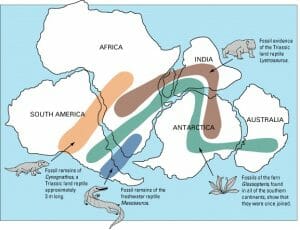Biogeography is the study of the distribution of living things and how they are effected by abiotic factors like oceans, rivers, mountains, valleys and climate. Broadly, the theory of evolution is supported by biogeography through evidence such as the species on Earth being distributed around the planet based on their genetic relationships to each other. The field of paleobiogeography uses the fossil record over billions of years along with geographic evidence to support evolutionary theory.
Paleobiogeography
This field of science incorporates historical geography and fossil evidence into the study of biogeography. Modern day studies include the use of molecular analysis to corroborate findings suggested by evidence in the fossil record. This technology has allowed scientists to understand where species first evolved on Earth back when the supercontinent Pangea was the only land mass on the planet. For example, work in this field has shown that perching birds first evolved in the area where Australia and Antarctica were once joined. Also, scientists have learned that many species of fish in the Amazon evolved as a result of allopatric speciation, but not all at once. The fossil record is distinct enough to show that new species emerged incrementally over tens of millions of years.
The theory of the supercontinent Pangea goes hand in hand in with the biogeography of fossils in supporting the evolutionary theory. Today, the fossil record along tectonic plates and the continental coasts are identical in some places, indicating that the land masses were once joined. Further evidence of a single land mass in the past is shown by the current coastlines of the continents that roughly fit together like the pieces of a jigsaw puzzle. The scientist Alfred Wegener introduced the idea continental drift in 1912 to explain the similarities in the fossil record in areas that are now so far apart. It wasn’t until the 1960’s that the idea of continental drift became accepted in the scientific community.

The image above shows the Snider-Pellegrini-Wegener fossil map depicting how plants and animals were distributed across the supercontinent of Pangea about 175 million years ago. This model explains how identical fossils and geological similarities are found in different areas of the world and how populations of species can become isolated and evolve over time.
References
- Biogeography. (n.d.). In Wikipedia. Retrieved June 27, 2017 from https://en.wikipedia.org/wiki/Biogeography
- Cline, A. (2016, September 12). How biogeography supports evolution. Inferential evidence from biogeography proves common descent. Retrieved from https://www.thoughtco.com/how-biogeography-supports-evolution-249883
How Does the Biogeography of Fossils Support Evolutionary Theory
No comments:
Post a Comment